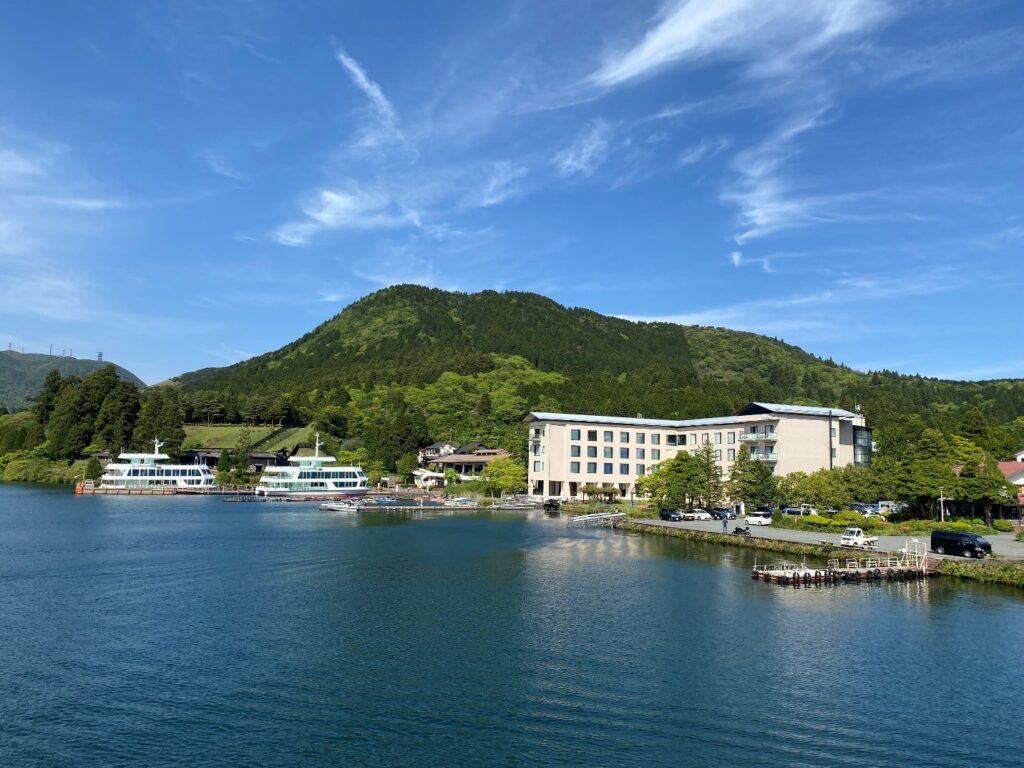There is nothing more memorable like spending a day or two or a week-end getaway in Hakone when you visit Japan for travel. Here in Hakone, you can see the spectacular and jaw-dropping view of Mount Fuji; cruise along the natural beauty of Lake Ashi; visit one of many museums to discover the historical and cultural of Japan; bath in one of many famous onsen (hot springs), experience the life of locals and many more.
Hakone is one of the popular and best-known tourist destinations in Japan and among Japanese. It is located just an hour and half trip by train from Tokyo. If you want, you can also take Romancecar, a luxurious train from Shinjuku Station in Tokyo directly to Hakone-Yumoto, the first town to start your day in Hakone. Alternatively, you can take Shinkansen (bullet train) from Tokyo station to Odawara station and then take Hakone Tozan train or bus from Odawara to Hakone Yumoto. You can also take Odakyu Highway bus from Shinjuku station to Gotemba station in Hakone.
If you want to travel in a convenience, efficient and economic way in Hakone, you can buy a 2-day or 3-day Hakone Free Pass that can be used for unlimited travel within designated area in Hakone using either train, bus, ropeway, cable car and cruise ship. Other than saving money from purchasing multiple tickets at regular price and saving time in purchasing tickets and selecting mode of transportations, this good value Hakone free pass offers discounts at more than 70 facilities in Hakone. You can use the pass to get discounts at many museums, hot springs (onsen), botanical gardens, scenic/historic places, dining and shopping facilities, and many others.
I have a separate complete article about Hakone Free Pass. You can click it here.
These are our top 9 tourist destinations in Hakone you have to visit and experience when you travel to Japan.
1. Exploring Hakone-Yumoto, the Vibrant and Lively District in Hakone

Hakone-Yumoto is a small town with a rich history as a hot springs area. It is just an hour and half trip from Tokyo’s Shinjuku Station by using the famous and luxurious Romancecar train. It is considered a gateway to Hakone area and is the first place to visit Hakone area.
Among other towns in Hakone, Hakone-Yumoto has the highest number of places of stay. You can find many hotels, ryokans (traditional Japanese inns), motels and hostels in here.
The first time you arrive and step out of Hakone-Yumoto station, you will be amazed with the rows of stores along the street overflowing liveliness. There are many souvenir shops, cafes, restaurants, sweet shops and small shops to just get a local snack to go. Searching for souvenirs and trying a local foods/snacks are one of the real pleasures of travelling.
If this is your first-time visiting Hakone and you are not sure where and how to go, you can visit Hakone-Yumoto Tourist Information Center located on the opposite of the train station near the bus station. The staffs there can provide helpful information in English, Chinese and Korean. They can also provide you with Hakone area map and tourist spot brochures.
If you want to relax and rejuvenate with a peaceful and natural setting after you spent your day in Hakone, you can settle in for a soak in one of many Japanese natural hot springs (onsens) in Hakone Yumoto. There are many health benefits of soaking in natural hot spring, such as, boosting blood circulation, reducing natural pain, reducing stress level, and soothing and healing skin irritation. You can find onsens inside ryokans, hotels or at independent public bath establishments. Some onsens can give you a discount if you have Hakone Free Pass with you. The notable onsens in Hakone-Yumoto are Hakone-Yuryo, Tenza, Hakone Kamon, Yunosato Okada and at Yumoto Fujiya Hotel.
Like in may cities or towns in Japan, Hakone-Yumoto has many Buddhist temples and shrines (Shinto place of worship) for people to worship, pay respect and visit. Two of them are Sounji temple (famous of its quiet charm and spiritual) and Amidaji Sanmon Gate (famous of its cave and hydrangeas blooming in late June and mid July).
In addition to all above, you can join a guided walking tour to explore the area. You can view and visit many beautiful Japanese gardens at ryokans or hotels that are open to public. If you want, you can rent kimono for you to wear while strolling Hakone-Yumoto or ride a rickshaw to take a tour around the town for 20 minutes or so.
You will be disappointed if you do not explore Hakone-Yumoto when you travel to Hakone. There are too many things for you not to miss here!
2. Riding Hakone Tozan Train from Hakone-Yumoto to Gora
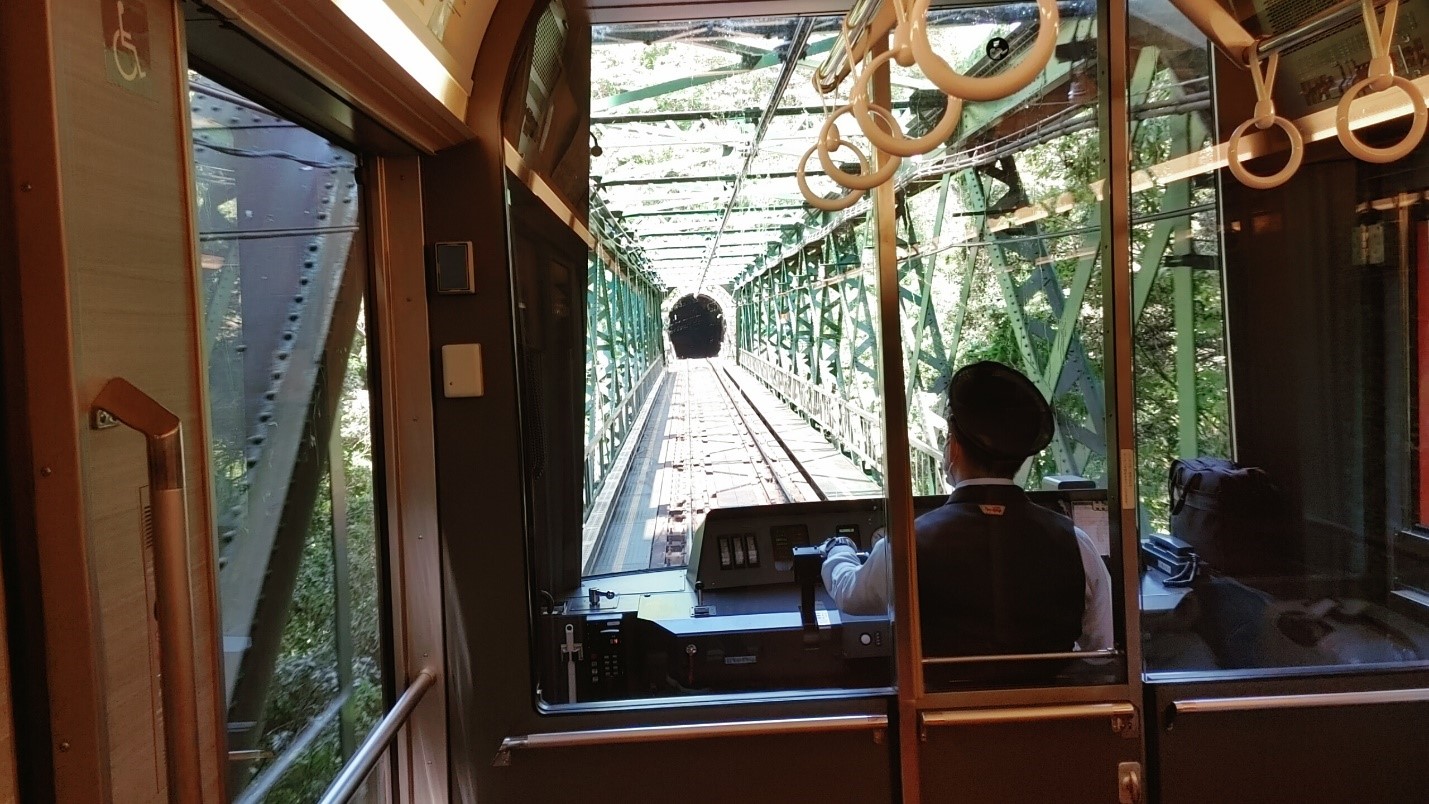
From Hakone-Yumoto you can take either a bus or train to Gora (a small town in Hakone famous for its Open-Air Museum). However, if you want to experience an unforgettable trip, you have to take Hakone Tozan Train.
This Japan’s oldest mountain train is very famous for tourists especially for the part between Hakone-Yumoto station (103 metre elevation) to Gora station (533 metre elevation). The train winds through a densely narrow wooded valley over many bridges and tunnels. In order to climb the mountain inclines, the train zigzags up the slopes and changes directions at three switchbacks. Passengers can enjoy scenery through the wide window and be wowed as the train climbs steep slopes.
When you take the ride, you will be wondered why after the train stops at one station it reverses back for few minutes before it heads again to the same direction. You may think that there is a problem with the train so that it has to return back to Hakone-Yumoto station. You will find out that this is the way the train travels from Hakone-Yumoto to Gora.
Hakone Tozan Train ride is especially beautiful in June and July when thousands of hydrangeas (ajisai) are in bloom along the tracks and are illuminated during the evenings. The ajisai are usually best around the beginning of July and can be seen from the train and around the stations. Special trains run from mid June through mid July between Hakone-Yumoto and Gora stations for the viewing of the illuminated flowers. They depart in the evenings and require seat reservations.
The trip to Gora is about 15 minutes. Along the ways, you can see the hills from afar that are covered with green color trees. It is so beautiful. It would be more beautiful if you visit there during the Fall season where the trees change their color.
Again, if you purchase Hakone Free Pass, the trip to Gora using Hakone Tozan Train is included in the pass. It is so convenient!
3. Visiting Hakone Open-Air Museum, a Harmony of Sculpture and Nature

If you like to explore museums, Hakone Open-Air Museum is a must to visit. It will give you different experience than visiting regular museums because most of the artworks and exhibits there are located outside the building.
Located within five minutes walk from Gora station, Hakone Open-Air Museum, as it is called, is an outdoor sculpture gallery spreads across 70,000 square meters of green garden. While you are admiring and appreciating the great artworks, you can stroll the area leisurely and view the beautiful nature of the surrounding mountains and hills.
If you have Hakone Free Pass, the admission fee to the Open-Air Museum is only 1,400 yen, a 200-yen discount from the normal adult fee of 1,600 yen. The museum has various sections and exhibition spaces outdoors and indoors. One of the notable showcases is the Picasso Exhibition Hall which has two stories of sculptures, paintings and ceramic works by the artist. It has over 300 artworks of painting, sculpture, tapestry and other objects.
Outdoor, one of the larger pieces is the Symphonic Sculpture, an 18-metre-tall glass lookout tower featuring a spiral staircase that allow visitors to admire the stained-glass artwork from the tower’s interior created by Gabriel Loire, a French stained-glass artist. Other than Symphonic Sculpture, the Sculpture Garden has approximately 120 masterpieces by modern and contemporary sculptors from both Japan and overseas.
For visitors with children, there is an area called “Woods of Net” where the children can go inside, enjoy and play in this structural piece. It is a wooden dome of stacked and glued laminated lumber with a giant hammock made of many colorful, interconnected hand-knit nets. The kids can experience this artwork by jumping, climbing and sitting on the balls. It is a very popular place for the kids to spend the time in Open-Air Museum.
The museum opens from 9:00 am to 5:00 pm and open year-round including during year-end and New Year period.
You can easily spend two to three hours to enjoy and admire the artworks at the museum.
4. Owakudani, Popular tourist site for its Scenic View and “Black Egg”

Although it can be reached by using bus, most people visiting Owakudani are using ropeway/gondola from either Sounzan or Togendai because they can view the beautiful scenery from above.
Located at 1,044 metres elevation, Owakudani is an area around a crater created during the last eruption of Mount Hakone some 3,000 years ago with a volcanic valley of active sulfur vents, hot springs and bubbling pools. You can see the steams coming out of volcano from inside the ropeway. When the day is clear with no clouds, you can easily see the wonderful views of the Hakone mountains and even Mount Fuji from inside the ropeway.
Owakudani is one of the most famous viewpoints in Hakone where you can see and observe the intense volcanic activity from above. Due to the active steaming vent from the volcano, sometimes the ropeway is suspended during extreme whether or hazardous situation for safety purposes. People with asthma, bronchitis, heart diseases, using pacemakers, having respiratory disease and pregnant women are advised not to enter the area due to high volcanic activity.

There are four buildings at Owakudani. The main building is the one where the ropeway station is located. The top floor of this building has a full of restaurants and small gift shop. There is another big building located not far from this main building with a huge souvenir shop. In here you can find many local snacks and sweets such as mochi, daifuku, cookies as well as bags, handkerchief, key chains, magnet etc. The most famous thing people buy at Owakudani is “black eggs” (kurotamago), hard-boiled eggs cooked using geothermal heat with black shells due to a chemical reaction from volcanic gasses and sulfurous waters. People said that one’s life can be extended by seven years by eating one “black egg”. The other two small buildings are an ice cream shop that sells black color ice cream & snacks and a small eatery where you can purchase the meals (mostly ramen) from vending machines.
Due to its famous, there are statues of “black egg” at Owakudani. During the busy seasons, people have to line up to just take a picture with the statue to be posted on their Instagram accounts.
Other than from inside ropeway, you can also see the clear view of Mount Fuji at Owakudani. One of the best spots to take a picture with Mount Fuji background is at the back of the building with “black egg” statue.
Owakudani is the center point of the famous route that takes you around Hakone in a circular route. You can take the route clockwise or counter clockwise, either way you can see the beautiful nature of Hakone.
5. Experiencing Hakone Sightseeing Cruise along Lake Ashi
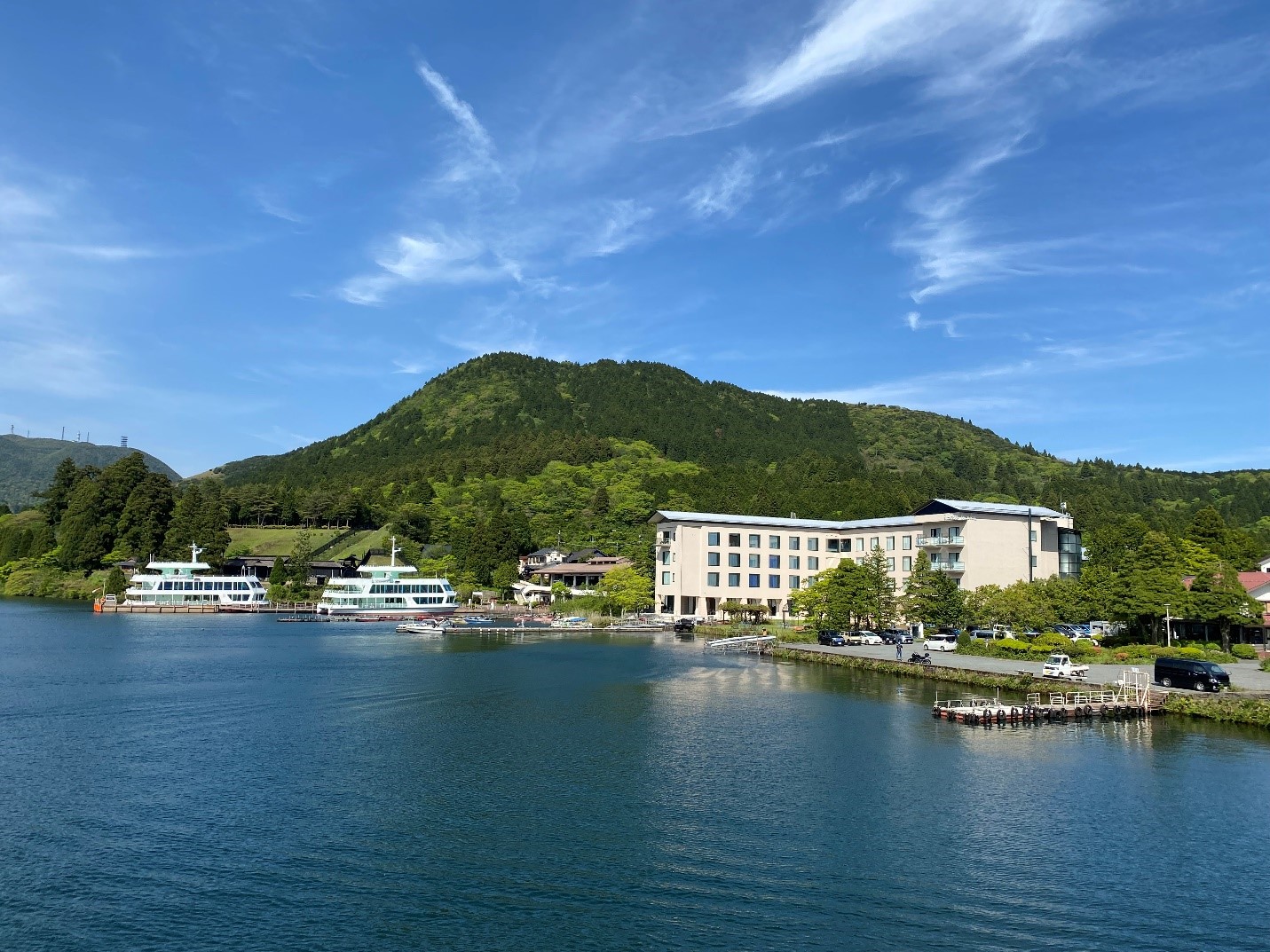
Taking Hakone Sightseeing Cruise is one of the best activities you can experience while you spend your days in Hakone.
You can take the cruise ship excursion along Lake Ashi from Togendai to Motohakone with a stop at Hakonemachi or the other way back from Motohakone to Togendai. The cruise takes between 30 to 40 minutes long. There are three different design of ships that resemble pirate ships. On the top deck, you can have a 360-degree view of the lake and Hakone area. The fare of the sightseeing cruise is included in Hakone Free Pass if you buy one. However, if you want to enjoy the luxury space inside the ship without crowd and with a great view from the front of the ship, you have to pay extra to enjoy this special room.
The grand nature of the ship will navigate you on Lake Ashi to enjoy the beautiful view of the lake with surrounding mountains/hills and the lake top Torii Gate of Hakone-jinja shrine. You can enjoy the majestic views during that sunny day where the contrast between the blue sky and the sparkling surface of the lake is at the most. On a clear day without clouds, you can view Mount Fuji between two mountains. Visibility is usually better in the colder seasons and in the early morning or late afternoon hours.
This experience is one of the long lasting memorable moments you can get when you visit Japan!
6. Viewing and enjoying Azalea Garden at Hotel de Yama (late Spring only)
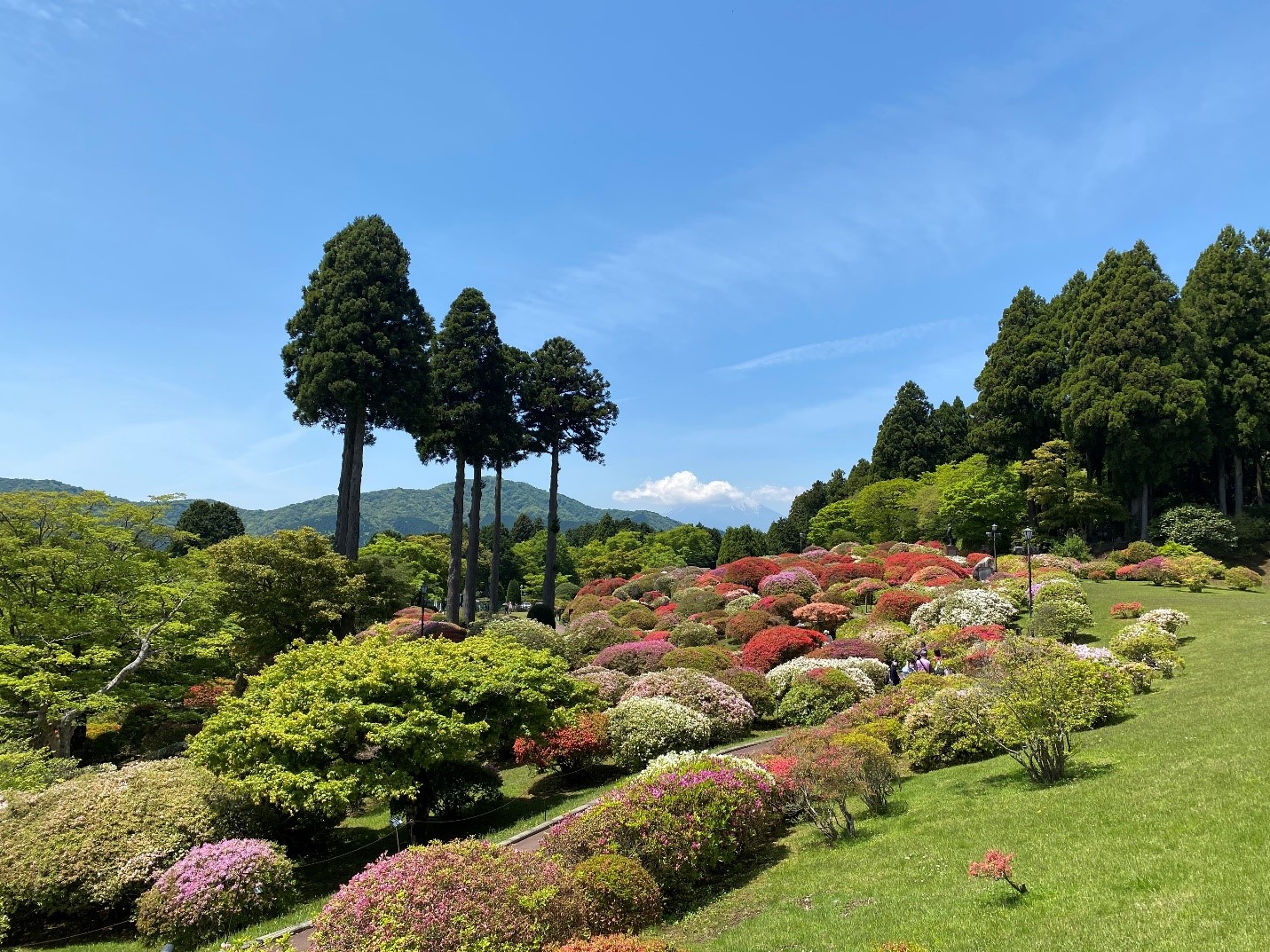
A lot of tourists visit Japan to see the beautiful Sakura (cherry blossom) blooming in the Spring time. However, not may people know that flower lovers can also enjoy the beauty of impressive blooms and dazzlingly colorful of azalea in a secret garden inside Hotel de Yama at Motohakone.
Every year in early May, the vast garden garden of Hotel de Yama on the shore of Lake Ashi begins to bloom with colorful azaleas with a gorgeous landscape of Mount Fuji and Lake Ashi. The garden is huge with 130,000 square meters in size. Not all inside the garden are azaleas. There are many big trees with a shady and leafy atmosphere.
This garden has more than 3,000 azalea bushes (Rhododendrons) from 70 varieties of species. The scenery inside the garden is very beautiful. The azalea garden is tucked in between the hotel building and the lake. You can take pictures with full bloom azaleas with the view of the deep blue color of Lake Ashi and the iconic Mount Fuji at the background. There are many visitors coming to the garden. The entrance fee to the garden is 1,000 yen per person (only while azaleas are blooming, other time is free).
There are free shuttle buses from Motohakone that can take you directly to Hotel de Yama.
7. Relaxing at one of many Hot-Springs (Onsens)

Hakone is famous for one of the best hot-spring districts in Japan. There are numerous hot-springs in Hakone for you to discover and experience, each with different quality, appeal and characteristic. Some of the onsen is private and limited only for people who stay at that establishment (ryokans, hotels). Many others are open to public. Although most hot springs there are for you to relax and bath, there are others that offer outdoor hot spring with water slides for children to play and spend the day.
The onsen, Japanese traditional hot spring, is an integral part of Japanese tradition and culture. Because of mountainous nature of Japan with many volcanoes, you can find a lot of hot-springs all over Japan. Many local people living in busy cities like Tokyo frequently visit Hakone during the week-end just to relax and rejuvenate with a peaceful setting by soaking in one of many onsens in Hakone.
There are onsens at the base of mountains that have a high alkaline level that is good for skin recovery. Other onsens at the upper highlands that are milky white is good for your skin. Depends on the onsen, some onsens offer baths with views of mountains or lakes from afar.
Many onsens have private and public indoor and outdoor bath houses and are separated by gender. You have to undress completely when you go inside the bath. You can cover your private with a towel before entering the pool. The water temperature is about 40 degrees Celsius. It is not too hot but hot enough to relax and stretch the muscles.
There are rules for you to follow when you want to get your bath at onsen. You have to wash your body completely before entering the shared bath. Taking pictures inside the bath room is a big no. Because this is a place for relax, you need to respect the tranquility and calm of the onsen experience and speak quietly. Most of onsens are not welcome for visitors with tattoo. However, there are some onsens allow people with tattoo to enter their baths.
Out of many onsens in Hakone, there is one onsen that has unique features, i.e., Yunessun at Kowakien near Gora. This is like a water amusement park on top of just regular hot spring. Yunessun has outdoor warm water pool with different kind of slides for children and adults to play. Other than that, according to their website, their indoor doomed area offers all-weather enjoyment including swimming in a large pool with Mediterranean Sea theme and luxuriating in baths containing wine, coffee or Japanese sake for a unique and entertaining experience.
8. Strolling and relaxing at Motohakone

Motohakone is a small town on the south shore of Lake Ashinoko. There are many small restaurants and souvenir shops along the main street of Motohakone. The lakeshore itself is quite big and wide. You can see a lot of tourists spending their time along the lakeshore walking or sitting enjoying the beautiful view of the lake. As well, you also can spot few people set up a small tent on the shore and sit holding long fishing rod on the lake. The atmosphere over there is pretty calm, laid back and relaxed. A perfect place to enjoy the afternoon time.

From the Motohakone port area, you can observe the breathtaking view of Lake Ashi with Mount Fuji and Hakone Jinja Torii Gate at the back. On a clear day, especially in the early morning, the crystal clear of Lake Ashi mirrors the mesmerizing appearance of Mount Fuji, making it an astounding view to behold. This is one of the best spots to view Mount Fuji in Hakone.
9. Taking Instagramable Picture at the Hakone-Jinja Torii Gate
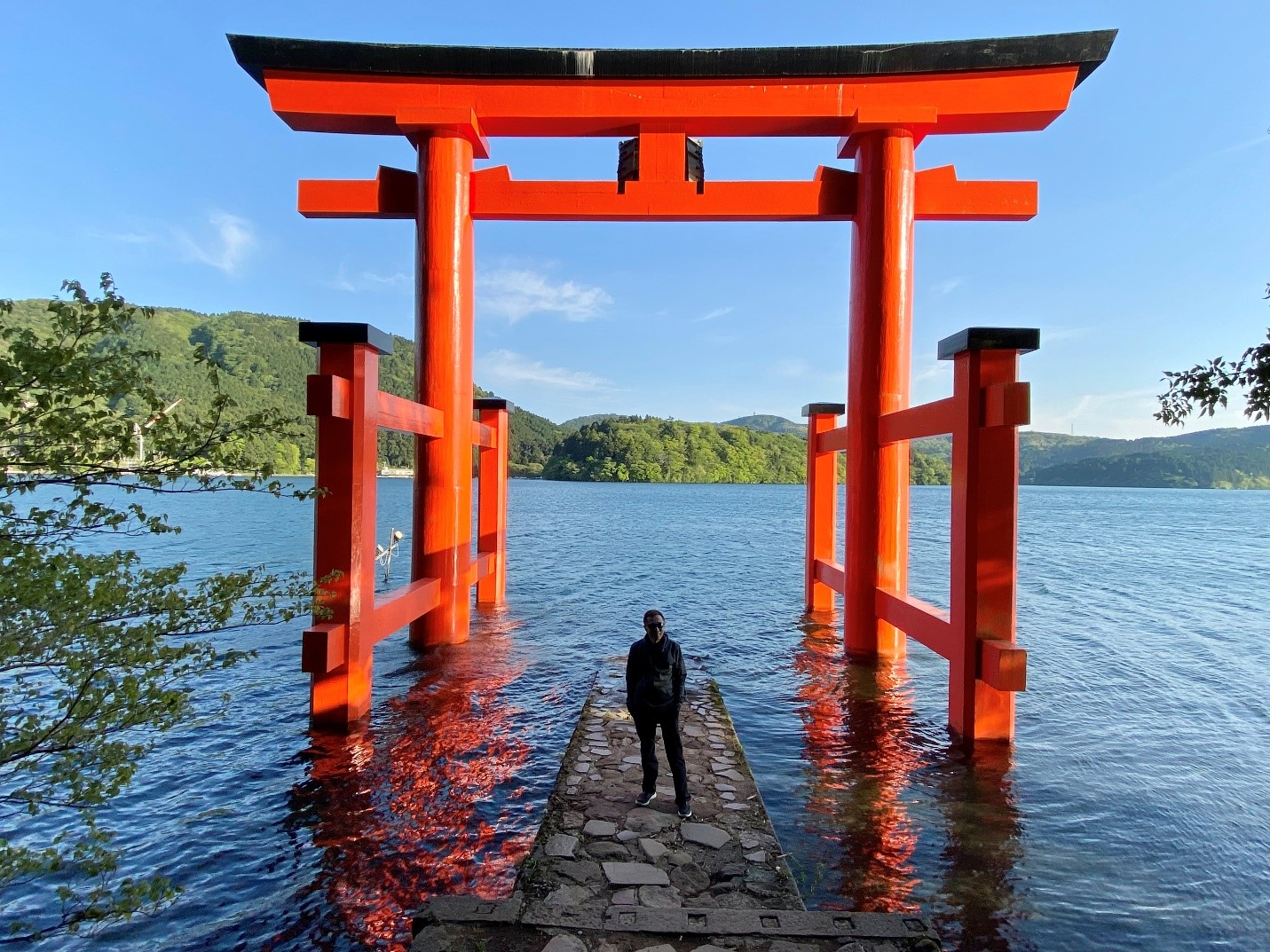
Although you can find many red-color Shinto torii gates across Japan, this torii gate in Hakone is a special one as it appears to be floating on the water. It is located right on the edge of Lake Ashi and there is a board from the lakeshore sticking out into the lake on which people can take photos.
From Motohakone town center you can walk along the shore of Lake Ashi to reach Hakone-jinja torii gate in about 15 minutes. Unless you reach there early in the morning, chances are you will see a long line up of people waiting their turn to take Instagrammable pictures on the board in front of the lake “framed” by the iconic torii gate, because it is a very good spot.
People over there are usually polite and helpful. They wait their turn to take the picture without distraction, unlike other popular photography landmarks where people are seen crowding each other out to get the best spots. Often the person behind the line offer to take the photo of the people in front of them.
Of course, if you don’t have enough time to wait for your turn or don’t bother your picture to having other random people in it, you can take the picture from afar with the background of the torii gate.
